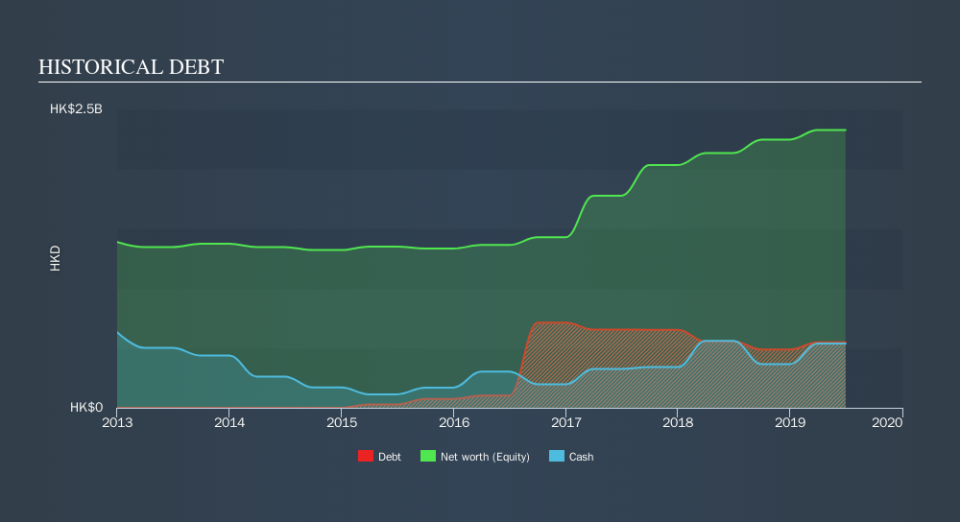O-Net Technologies (Group) (HKG:877) Seems To Use Debt Quite Sensibly

The external fund manager backed by Berkshire Hathaway's Charlie Munger, Li Lu, makes no bones about it when he says 'The biggest investment risk is not the volatility of prices, but whether you will suffer a permanent loss of capital. When we think about how risky a company is, we always like to look at its use of debt, since debt overload can lead to ruin. As with many other companies O-Net Technologies (Group) Limited (HKG:877) makes use of debt. But the more important question is: how much risk is that debt creating?
When Is Debt A Problem?
Generally speaking, debt only becomes a real problem when a company can't easily pay it off, either by raising capital or with its own cash flow. Ultimately, if the company can't fulfill its legal obligations to repay debt, shareholders could walk away with nothing. While that is not too common, we often do see indebted companies permanently diluting shareholders because lenders force them to raise capital at a distressed price. Of course, the upside of debt is that it often represents cheap capital, especially when it replaces dilution in a company with the ability to reinvest at high rates of return. The first thing to do when considering how much debt a business uses is to look at its cash and debt together.
Check out our latest analysis for O-Net Technologies (Group)
What Is O-Net Technologies (Group)'s Net Debt?
The chart below, which you can click on for greater detail, shows that O-Net Technologies (Group) had HK$549.3m in debt in June 2019; about the same as the year before. However, because it has a cash reserve of HK$537.9m, its net debt is less, at about HK$11.4m.
A Look At O-Net Technologies (Group)'s Liabilities
We can see from the most recent balance sheet that O-Net Technologies (Group) had liabilities of HK$1.12b falling due within a year, and liabilities of HK$102.3m due beyond that. Offsetting these obligations, it had cash of HK$537.9m as well as receivables valued at HK$947.8m due within 12 months. So it actually has HK$262.6m more liquid assets than total liabilities.
This short term liquidity is a sign that O-Net Technologies (Group) could probably pay off its debt with ease, as its balance sheet is far from stretched. But either way, O-Net Technologies (Group) has virtually no net debt, so it's fair to say it does not have a heavy debt load!
In order to size up a company's debt relative to its earnings, we calculate its net debt divided by its earnings before interest, tax, depreciation, and amortization (EBITDA) and its earnings before interest and tax (EBIT) divided by its interest expense (its interest cover). This way, we consider both the absolute quantum of the debt, as well as the interest rates paid on it.
O-Net Technologies (Group) has very little debt (net of cash), and boasts a debt to EBITDA ratio of 0.026 and EBIT of 15.0 times the interest expense. So relative to past earnings, the debt load seems trivial. While O-Net Technologies (Group) doesn't seem to have gained much on the EBIT line, at least earnings remain stable for now. The balance sheet is clearly the area to focus on when you are analysing debt. But it is future earnings, more than anything, that will determine O-Net Technologies (Group)'s ability to maintain a healthy balance sheet going forward. So if you want to see what the professionals think, you might find this free report on analyst profit forecasts to be interesting.
Finally, a company can only pay off debt with cold hard cash, not accounting profits. So we clearly need to look at whether that EBIT is leading to corresponding free cash flow. Over the last three years, O-Net Technologies (Group) saw substantial negative free cash flow, in total. While that may be a result of expenditure for growth, it does make the debt far more risky.
Our View
Based on what we've seen O-Net Technologies (Group) is not finding it easy conversion of EBIT to free cash flow, but the other factors we considered give us cause to be optimistic. There's no doubt that its ability to cover its interest expense with its EBIT is pretty flash. When we consider all the elements mentioned above, it seems to us that O-Net Technologies (Group) is managing its debt quite well. But a word of caution: we think debt levels are high enough to justify ongoing monitoring. Over time, share prices tend to follow earnings per share, so if you're interested in O-Net Technologies (Group), you may well want to click here to check an interactive graph of its earnings per share history.
If you're interested in investing in businesses that can grow profits without the burden of debt, then check out this free list of growing businesses that have net cash on the balance sheet.
We aim to bring you long-term focused research analysis driven by fundamental data. Note that our analysis may not factor in the latest price-sensitive company announcements or qualitative material.
If you spot an error that warrants correction, please contact the editor at editorial-team@simplywallst.com. This article by Simply Wall St is general in nature. It does not constitute a recommendation to buy or sell any stock, and does not take account of your objectives, or your financial situation. Simply Wall St has no position in the stocks mentioned. Thank you for reading.

